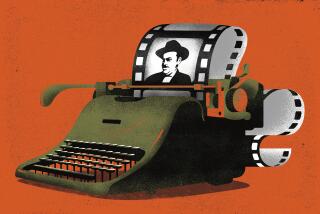The ‘Brass Ring’ That Eluded Orson Welles
- Share via
Nothing Orson Welles did or touched was uninteresting. Even when he risked seeming to be a parody of himself--uttering those wine commercials or, one memorable night, leaning on a cane in the spotlight in a Las Vegas showroom and paying Shakespearean homage to Frank Sinatra--his bravura confidence saved him.
The moments became pure Welles, saved from parody by his adroit command of his vast, majestic presence. There was an implicit wink, as if to signal his admirers that it was the surviving that mattered.
The sadness of his last years was that he continued to be incessantly creative, drafting scripts, outlining projects, conducting negotiations. But virtually nothing came to fruition. His last film, “The Other Side of the Wind,” a trenchant and ingenious commentary on Hollywood old and new, remains a teasing treasure of which only 20 minutes or so have been shown in public.
One of the projects that very nearly made it was an original screenplay by Welles called “The Big Brass Ring,” with his longtime associate, the Yugoslav actress-sculptor Oja Kadar, listed as co-author. It has now been published in a limited edition of 1,000 copies by Santa Teresa Press (Box 2711, Santa Barbara, Calif. 93120, $25).
There is a preface by film historian James Pepper, who organized the book, and an afterword by Chicago critic Jonathan Rosenbaum on the history of the script and other projects from Welles’ last several years.
Another director, Bernardo Bertolucci, once called a script “a starting point from which to explode,” and it is even more difficult than usual to envision all that Welles would have done visually with the talky but cryptic “The Big Brass Ring.”
It is an American political drama, set largely in Spain in present time. (Welles’ final draft is dated 1982.) Rosenbaum, quoting Henry Jaglom, at whose urging Welles undertook the project, reports that the principal characters were very loosely inspired by historical figures Welles knew.
The characters are an ancient homosexual, a presidential adviser from the Franklin Roosevelt years, and a young, rich presidential candidate for whom the older man has been mentor and probably more. It is an association the young man’s backers want to bury as being more damaging to his candidacy than pot-smoking. But the two meet again in Europe amid the still-existing fragments of their tangled past (including a mysterious Eurasian lady the candidate truly loved but whom the mentor drove off).
It is a script of wonderful Wellesian oddments: a diuretic monkey, a lost necklace discovered to be fake, assorted tough-talking goons and political hangers-on, a tough but loving wife, a nosy Italian journalist vaguely echoing Oriana Fallaci (to have been played by Kadar) and as the set-piece, an erotic recoupling of the candidate and the Eurasian love during the fireworks of a feria while the mentor watches voyeuristically from a convenient Ferris wheel. There is at last the murder of a blind beggar.
Arnon Milchan (“Brazil”) was eager to produce the film, if a bankable male star could be found to play the candidate. (Welles was to play the aged mentor.) Clint Eastwood, Warren Beatty, Jack Nicholson and three other stars were solicited. Each, for various reasons, turned it down and the project died.
In 1973 the English critic Peter Cowie identified 25 undone Welles film projects, including 17 in script form, everything from a bullfight film to a biography of Alexandre Dumas. Rosenbaum now identifies several more, among them “The Dreamers” by Isak Dinesen, for which Welles wrote nine drafts, and an adaptation of Jim Thompson’s hard-boiled novel, “A Hell of a Woman.”
Jaglom has said he thought “The Big Brass Ring” would have revealed as much about the present U.S. as “Citizen Kane” and “The Magnificent Ambersons” revealed about the U.S. of the early 20th Century. Welles thought it was about the choices a man makes in his life, and then wonders about.
Even in this last draft form, “The Big Brass Ring” has a tentative feeling, as if it had been set aside rather than finished. There are what read like marginal notes identifying lesser characters and their histories. It seems more than usually a point of departure. But, Welles being Welles, there is no doubt it could have been a hell of a journey.
In the end the principals are singing old Hasty Pudding songs from Harvard days, resigned to the wreckages of their lives. “If you want a happy ending,” Welles says, “that depends, of course, on where you stop your story.”
More to Read
Only good movies
Get the Indie Focus newsletter, Mark Olsen's weekly guide to the world of cinema.
You may occasionally receive promotional content from the Los Angeles Times.








